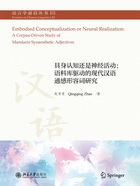
CHAPTER 1
Introduction to synaesthesia
Synaesthesia, with an alternative spelling as synesthesia, has the etymological roots syn ‘together’ and aisthesia‘perception’in Greek (Popova 2005; Ronga et al.2012). It describes a situation where perceptions in different sensory modalities are associated in both perceptual experiences and linguistic expressions (Ullmann 1957; Williams 1976; Cytowic 1993; Shen and Eisenman 2008).[1]
The association of sensory modalities in perceptual experiences, named “neurological synaesthesia” alternatively, is an uncommon phenomenon in which a capacity to experience sensations in one modality is manifested when a different modality is stimulated, or a percept in one sub-modality is elicited by a stimulus belonging to another sub-modality. Examples include tasting shapes, perceiving colors from black-printed graphemes, and so on (see Cytowic 1993; Cytowic 2002 [1989]; Banissy et al.2015). Neuroscientists, such as Ramachandran and Hubbard (2001)and Hubbard and Ramachandran (2005), have suggested that synaesthesia in perceptual experiences is a neural disorder caused by defective pruning of connections between brain regions. However, more recent studies, such as Ward et al.(2006), Marks and Mulvenna (2013), and Banissy et al.(2014), have considered neurological synaesthesia a special cognitive condition. These studies have assumed that neurological synaesthesia recruits cross-modal mechanisms perceptually and cognitively common to all human beings rather than special neural pathways absent for most people.
Synaesthesia in linguistic expressions, also termed as “linguistic synaes-thesia” or “synaesthetic metaphor” in the literature, involves description of perceptions in one sensory modality in terms of lexical items from other modalities (e.g., Yu 2003; Ronga et al.2012; Strik Lievers 2017). Typological investigations conducted by Ullmann (1966 [1963])and Viberg (1983)have found that this kind of language usage appears cross-linguistically. For instance, the English gustatory adjective sweet can be used to describe an auditory perception, as in the phrase sweet voice; and the Mandarin tactile adjective 冷 leng3 ‘cold’ can modify a visual perception, as in the expression 冷色 leng3-se4‘cold color’.[2]
Extensive studies have been conducted on neurological synaesthesia to further out understanding of human perception and cognition (see Cytowic 2002 [1989]; Simner and Hubbard 2013; Banissy et al.2015). By contrast, less attention has been given to linguistic synaesthesia, especially the widespread synaesthetic usages in non-poetic languages (Strik Lievers 2015; Zhao et al.2018b). In addition, Rakova (2003)and Zhao et al.(2019)have demonstrated that linguistic synaesthesia would pose a challenge to linguistic theories including Conceptual Metaphor Theory (CMT)and the theory of embodiment (see Lakoff and Johnson 1980; Lakoff and Johnson 1999), as concepts are mapped from one concrete sensory domain to another concrete sensory domain in linguistic synaesthesia, rather than from the concrete to the abstract as in canonical metaphors. Furthermore, the significant research value of linguistic synaesthesia in the examination of neurological synaesthesia and of the interaction between neuro-cognitive activities and linguistic conceptualizations has been confirmed by various studies, such as Cacciari (2008), Marks and Mulvenna (2013), Caballero and Paradis (2015), and so forth. Therefore, this book will focus on linguistic synaesthesia. More specifically, I will examine the transfer patterns and underlying mechanisms of linguistic synaesthesia in a hitherto less-studied language, Mandarin Chinese, and the nature of linguistic synaesthesia will be clarified based on the tendencies of Mandarin synaesthesia. Last but not least, the theoretical implications of linguistic synaesthesia will be shown, including refinement of CMT and the embodiment theory.
This chapter presents a review of the relevant literatures on linguistic synaesthesia in general and linguistic synaesthesia of Chinese in particular. A brief overview of this book will also be given at the end of the chapter.